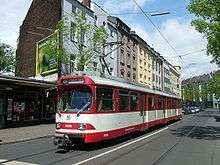Trams in Bremen
 A GT8N tram in Bremen. | ||||||||||||||||||||||||
| Operation | ||||||||||||||||||||||||
|---|---|---|---|---|---|---|---|---|---|---|---|---|---|---|---|---|---|---|---|---|---|---|---|---|
| Locale | Bremen, Bremen, Germany | |||||||||||||||||||||||
| ||||||||||||||||||||||||
| ||||||||||||||||||||||||
The Bremen tramway network (German: Straßenbahnnetz Bremen) is a network of tramways forming part of the public transport system in Bremen, Germany. The network is currently operated by Bremer Straßenbahn AG (which means Bremen Tramways Company Ltd) (often abbreviated BSAG). As of 2014, the network had 7 lines,[1] extending over 114.6 kilometres (71.2 mi) of route (up from 110.6 kilometres (68.7 mi) of route in 2011).[2]
Lines
| Line | Route | No. of stops | every ... minutes |
|---|---|---|---|
| 1 | Huchting – Am Brill – Hauptbahnhof – Neue Vahr – Osterholz – Tenever – Weserpark – Bremen-Mahndorf station | 44 | 7.5 to 10 |
| 1S | Only in this direction: Tenever – Osterholz – Neue Vahr – Kirchbachstraße → continues as line 1E | 13 | 20(only morning rush hour) |
| 2 | Gröpelingen – Walle – Am Brill – Domsheide – Hastedt – Sebaldsbrück | 33 | 10 |
| 3 | Gröpelingen – Überseestadt – Am Brill – Domsheide – Weserstadion – Weserwehr | 29 | 10 |
| 4 | Falkenberg – Borgfeld – Horn-Lehe – Hauptbahnhof – Domsheide – Huckelriede – Arsten | 39 49 | 5 to 10 (Borgfeld - Arsten) 15 to 20(Falkenberg - Arsten) |
| 4S | continues/arrives as line 4 → Kirchbachstraße – Horn-Lehe – Borgfeld – Falkenberg | 16 | 15(only rush hour) |
| 6 | Universität – Riensberg – Hauptbahnhof – Domsheide – Flughafen | 25 | 5 to 6 |
| 8 | Huchting – Am Neuen Markt (Neustadt) – Domsheide – Hauptbahnhof – Kulenkampffallee | 21 | 10 to 20 |
| 10 | Gröpelingen – Walle – Hauptbahnhof – Hastedt – Sebaldsbrück | 32 | 10 |
The lines with the suffix "S" (e.g. line 1S) are express lines, which do not stop at every station. Line 3S was discontinued in 2014 because of lack of available trams.
History
Horse tramway
On March 28, 1876 the Aktiengesellschaft Bremer Pferdebahn was founded.[4] The enterprise opened a horse tramway line from Herdentor to Vahrster Brücke on June 4, 1876,[4] extending the line to Horn in 1877.[4] In 1883, the extension from Herdentor to the stock exchange in the city centre was opened.[4]
The rival company Große Bremer Pferdebahn, which used British capital, opened a line from Hastedt to Walle on 3 November 1879;[4] today's line 2 partly follows the trajectory of that horse line. Both companies extended their network, and lines were opened to Freihafen (1888), Hohentor (1889) and Arsterdamm (1880/1884).
Electric tramway
In 1890, the line from the Stock Echange to the Bürgerweide exhibition grounds was electrified as a trial for the duration of an exhibition. Once the exhibition had ended, the overhead line equipment was removed, but the system had worked so well that it was decided to electrify all tramways. Electrification started in 1892,[4] and lasted until 1913. By then the network was fully electrified, with the exception of the Freihafen line, which had since been abandoned. Meanwhile, Große Bremer Pferdebahn merged with the Bremer Pferdebahn (which had renamed itself to Bremer Straßenbahn in 1890) in 1899.
In 1908, line numbers were introduced.[4] By 1939, the network consisted of the following lines:
- 1: Ringbahn
- 2: Gröpelingen - Markt - Sebaldsbrück
- 3: AG Weser - Markt - Hohwisch
- 4: Horn - Bahnhof - Markt - Arsterdamm
- 5: Flughafen - Markt - Bahnhof - Hemmstraße
- 6: Vulkanstraße - Brill - Bahnhof - Hemmstraße
- 7: Hartwigstraße - Bahnhof - Markt - Rablinghausen
- 8: Gröpelingen - Burg
- 10: Friedrich-Karl-Straße - Bahnhof - Waller Bahnhof
- 11: AG Weser - Norddeutsche Hütte
- 12: Sebaldsbrück - Osterholzer Friedhof
- 15: Hemmstraße - Bahnhof - Markt - Pappelstraße - Emder Straße (über Westbrücke)
- 16: Gastfeldstraße - Brill - Bahnhof - Wachmannstraße
The system suffered severe damage during World War II - tram services were abandoned on 22 April 1945. After WWII had ended, only 10% of the rolling stock was in working order, and 80% of the overhead lines had been damaged.
World War II aftermath
On 13 June 1945 the first tramways resumed operation. In the immediate aftermath of WWII, the Bremen network was split in two, as the bridges over the river Weser had been destroyed. In 1947, the two parts of the network were reconnected, and apart from the tram line over the Stephanibrücke, the 1950s BSAG network re-attained its pre-war extent.
In 1953, bus traffic was taken over by the BSAG. The new Flughafendamm workshop near Bremen Airport was constructed in 1959; in 1963 the head offices also moved to that site.
In 1965, the main passenger transfer stop was relocated from the Marketplace to Domsheide.
Line closures
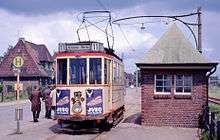
Bremen, like other cities in the world, had lines close in the 1950s and 1960s due to increased use of automobiles. On the following lines, service was abandoned:
- Line 8 1949 (Trolleybus at first, from 1961 diesel bus)
- Line 12 1952
- Line 10 in St.-Jürgen-Straße
- Line 5 1964
- Line 7 1965
- Line 6 1965/67. The rails in Pappelstraße were used until 2001.
- Line 11 1970
- Line 4 1972, the section Kirchbachstraße - Arsterdamm had been taken over in 1967 by the new Line 1. The line reopens in 1998.
Lines 15 and 16 were renumbered to lines 5 and 6 in 1967.
Network extensions
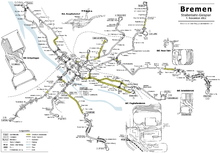
However, some lines were also notably extended:
- Line 3 to Gröpelingen 1949
- Line 16 to Grolland 1955, from 1976 (then line 6) to Huchting
- Line 6 to Gastfeldstraße 1955 (closed in 1967)
- Line 16 to Riensberg 1959
- Line 15 to Kulenkampffallee 1960
- Line 10 to Georg-Bitter-Straße 1963, to Sebaldsbrück and Gröpelingen 1975. The rails in Georg-Bitter-Straße continue to be used by extra trains.
- Line 1; new line Arsterdamm - Blockdiek, extended 1968 to Osterholz, from 1973 to Arsten, renamed to line 4 and extended to Arsten Süd on 7 December 1998.[5]
- Line 4 reopened to Horn-Lehe 23 May 1998, extension to Borgfeld on 6 December 2002.
- Line 6 newly built between Flughafendamm and Flughafen, replaces old part of Line 5 on 23 May 1998.
- Line 6 extension between Riensberg and Universität, opened October 10, 1998.
- Line 3 new route via Überseestadt, opened December 2, 2006.
- Line 1 extension between Schweizer Eck (formerly Züricher Str.) and Nußhorn, opened March 26, 2012.[5]
- Line 1 extension between Nußhorn and Mahndorf Station, opened April 2, 2013.[5]
- Line 4 extension between Borgfeld and Falkenberg, opened August 1, 2014
Fleet
Current
GT8N
In the late 1990s, the Hansa-built stock dating from the 1960s was scheduled for replacement. Since the BSAG had already invested in low-floor buses, low-floor tram vehicles were wanted as well. In 1990, the BSAG presented a prototype to the public. This three-section articulated car was the world's first 100% low-floor tram. From 1993 to 1996, 78 low-floor trams, classed as type GT8N, were ordered from AEG. Their main difference from the prototype is that they have four sections instead of three, hence offering more space and so more beneficial for wheelchair users. One vehicle has been taken out of service after an accident. The prototype was sold to the Norrköping tramways in Sweden in 1999.
GT8N-1

The GT8N-1 is the newest tramway vehicle in BSAG's rolling stock fleet. The first car was delivered in September 2005, with a total number of 20 trams ordered from Bombardier, with an option for a further 23 vehicles.
The GT8N-1 is the second generation of low-floor tramcars in Bremen. Its task is to replace older GT4 Wegmann vehicles and to provide increased comfort for BSAG passengers. Therefore, several changes were made compared to the older GT8N low-floor cars. The width of the car has been increased to 2.65 m, which makes the interior more spacious and allows the introduction of four seats abreast; altogether 106 seats are available. Passenger air-conditioning has also been installed, while five low-floor doorways and a lift for disabled passengers facilitate entry for all passengers.
The vehicle has an overall length of 35,400 mm and a maximum speed of 70 km/h. It consists of three sections with a total of four bogies. Two of these support the middle section of the car, while the two end sections are carried by a bogie each. The end section bogies are driven, which is why it was not possible to create a low floor above them as elsewhere in the car. Altogether the GT8N-1 is 74% low floor.
The GT8N-1 is based on Bombardier's FLEXITY Classic modular tramcar concept. Vehicles of this type run in several cities in Germany as well as in Poland and Australia. The first car of this family was the 8NGTW, delivered in 1997 to KVG Kassel. The Bremen version is uni-directional for use on BSAG's tram network. A possible future variant would be a similar but bi-directional, dual-system vehicle that could also be used on DB tracks and so could connect BSAG's inner-city tram network with railway lines.
Earlier
GT4
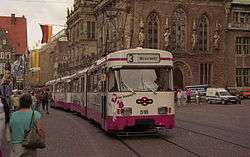
The oldest vehicles in active service until 2013 were the articulated tramcars of types GT4d, GT4e and GT4f and the matching trailers of types GB4d, GB4e and GB4f. The vehicles were built between 1973 and 1977 by Wegmann & Co. in Kassel. Of the 61 trams and 57 trailers originally delivered, four GT4f vehicles are still in service, though limited to driver training purposes and other special occasions. The rest have been scrapped or delivered to Timișoara in Romania.
Historic BSAG cars
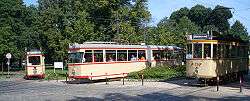
In Bremen some historic tram cars still exist:
- car Nr. 49 from 1900 (the only car which is only allowed to operate without passengers)
- car Nr. 134 from 1904 (the only car not in original design, in the design of 1939, see picture right side)
- car Nr. 701 from 1947 (see picture left side)
- GT3-car Nr. 917 from 1957 (special construchtion with 3 axles, see middle of picture)
- T4-car Nr. 811 / 1806 from 1954
- GT4-car Nr. 446 / 1458 from 1967
See also
References
Notes
- 1 2 "BSAG: Linien und Fahrpläne" (in German). Bremer Straßenbahn AG (BSAG). Retrieved 2014-10-15.
- 1 2 3 "BSAG IN ZAHLEN 2012" [BSAG IN FIGURES 2012] (PDF) (in German). Bremer Straßenbahn AG (BSAG). 2012. Retrieved 2013-10-13.
- ↑ "BSAG - About BSAG". Bremer Straßenbahn AG (BSAG). Retrieved 2013-10-13.
- 1 2 3 4 5 6 7 "Unternehmen - Geschichte und Archiv - Chronologie" [Enterprise - History and Archives - Chronology] (in German). Bremer Straßenbahn AG (BSAG). Retrieved 2013-10-14.
- 1 2 3 "Chronik 1" [Chronicle [Line] 1]. BahnBremen.de (Über die Straßenbahn in Bremen) (in German). Retrieved 2013-10-13.
Bibliography
- Höltge, Dieter (1992). Straßen- und Stadtbahnen in Deutschland [Tramways and Stadtbahnen in Germany] (in German). Band 2: Niedersachsen/Bremen [Volume 2: Lower Saxony/Bremen] (2nd ed.). Freiburg i. B., Germany: EK-Verlag. ISBN 3882553367.
- Schwandl, Robert (2012). Schwandl's Tram Atlas Deutschland (in German and English) (3rd ed.). Berlin: Robert Schwandl Verlag. pp. 26–29. ISBN 9783936573336.
External links
| Wikimedia Commons has media related to Trams in Bremen. |
- BSAG homepage (German)
- BSAG homepage
- pics of Bremen trams
- 360 degrees interactive panoramas from inside BSAG trams
- List of line openings and closures (German)
- Bremen database / photo gallery and Bremen tram list at Urban Electric Transit – in various languages, including English.
- Bremen database / photo gallery at Phototrans – in various languages, including English.
Coordinates: 53°04′54″N 08°48′48″E / 53.08167°N 8.81333°E




